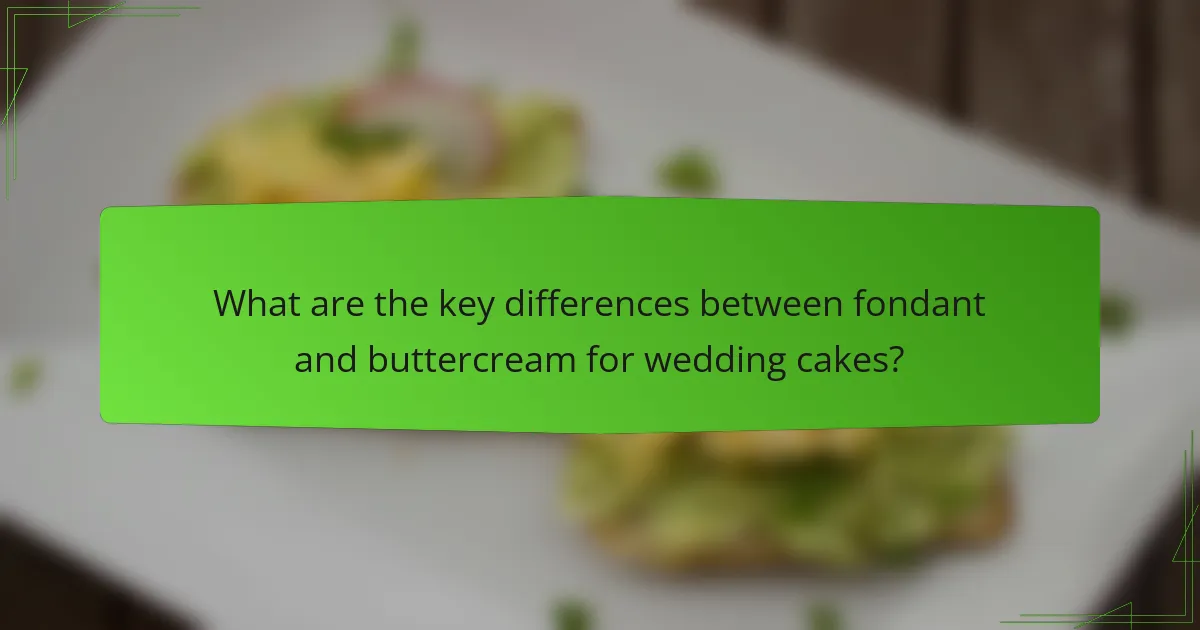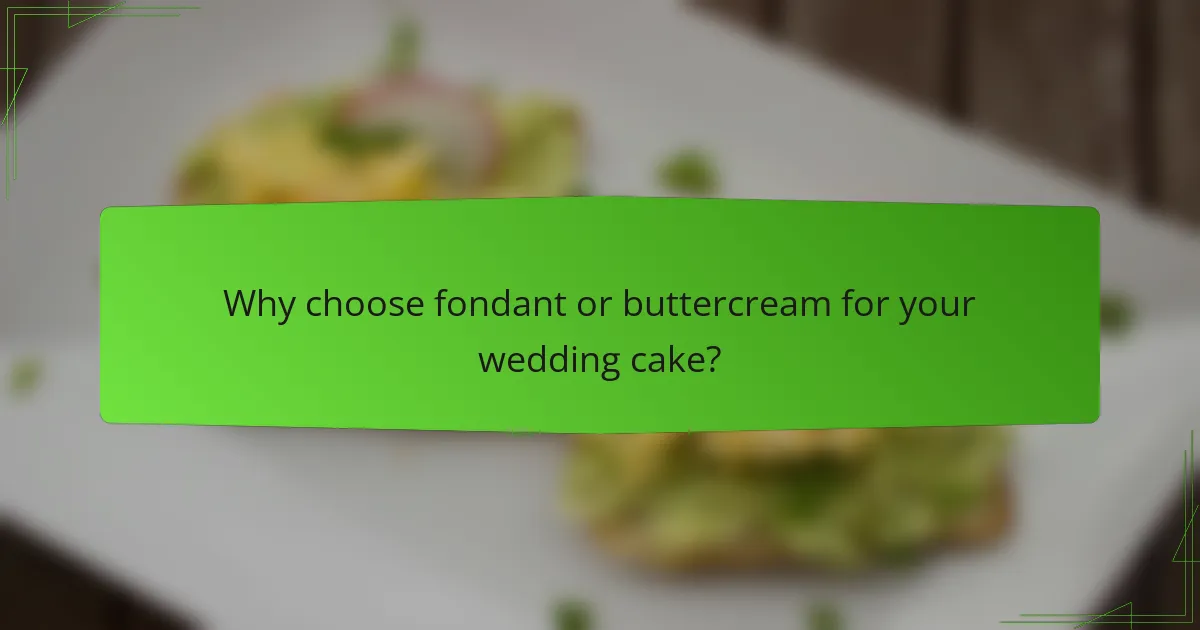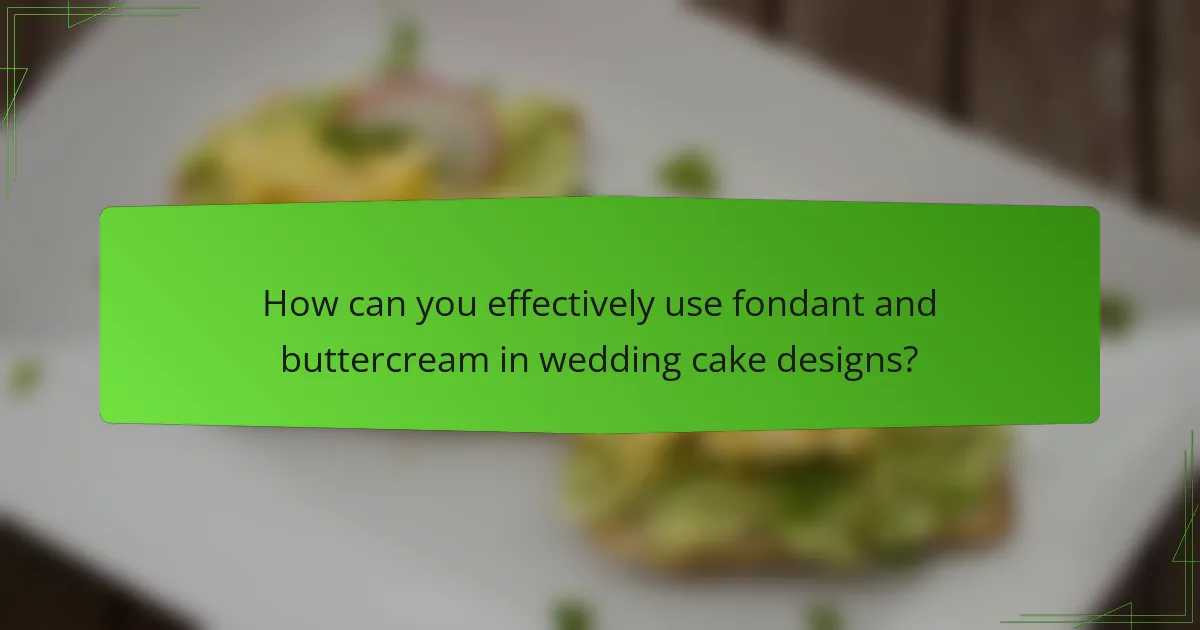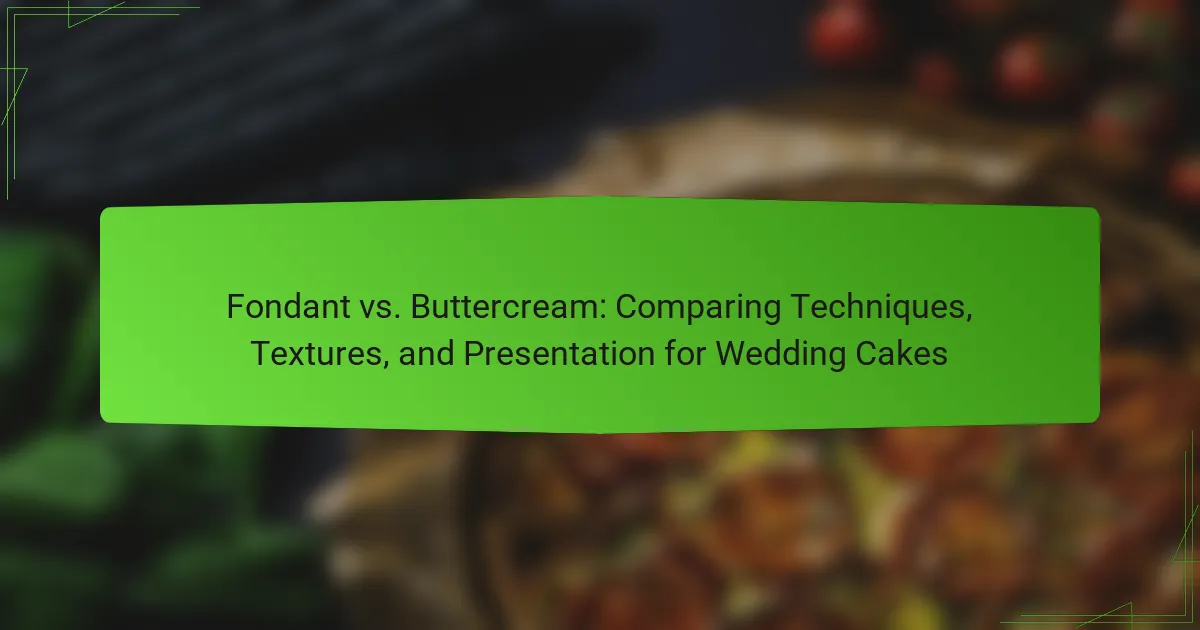
What are the key differences between fondant and buttercream for wedding cakes?
Fondant and buttercream differ significantly in texture, taste, and application for wedding cakes. Fondant is a smooth, pliable icing made from sugar, water, and gelatin. It provides a sleek, polished finish and allows for intricate decorations. Buttercream, on the other hand, is a creamy mixture of butter, sugar, and flavorings. It offers a rich taste and can be easily spread or piped.
Fondant creates a firmer exterior that can withstand heat and humidity better than buttercream. Buttercream is softer and may melt in warm conditions. Fondant is often preferred for elaborate designs, while buttercream is favored for its flavor and easier application.
In terms of taste, buttercream is generally sweeter and richer due to its butter content. Fondant has a more neutral flavor, often described as sugary. Each option has its unique attributes, making them suitable for different wedding cake styles and preferences.
How do the techniques for applying fondant and buttercream differ?
Fondant and buttercream application techniques differ significantly. Fondant is rolled out and draped over the cake for a smooth finish. It requires a firm base layer, often buttercream, to adhere properly. In contrast, buttercream is spread or piped directly onto the cake. This technique allows for texture and design variations. Fondant provides a polished look, while buttercream offers a softer, more traditional appearance. Each technique influences the cake’s final aesthetic and flavor profile.
What are the steps involved in working with fondant?
The steps involved in working with fondant include preparing the surface, rolling out the fondant, and applying it to the cake. First, ensure the cake is crumb-coated to create a smooth base. Next, dust a clean surface with cornstarch or powdered sugar to prevent sticking. Roll the fondant to an even thickness, typically about 1/8 inch. Carefully lift the rolled fondant and position it over the cake. Smooth the fondant down the sides, eliminating air bubbles. Trim any excess fondant at the base of the cake. Finally, decorate the fondant as desired. These steps ensure a professional finish on cakes, widely used in wedding cake design.
What are the steps involved in working with buttercream?
To work with buttercream, follow these steps. Start by gathering all necessary ingredients. Common ingredients include unsalted butter, powdered sugar, milk, and vanilla extract. Next, soften the butter to room temperature for easy mixing. Beat the softened butter until creamy and smooth. Gradually add powdered sugar while mixing on low speed. This prevents the sugar from flying out of the bowl. Once incorporated, add milk and vanilla extract to achieve desired consistency. Mix until the buttercream is fluffy and light. Adjust the thickness by adding more powdered sugar or milk as needed. Finally, use the buttercream for frosting or decorating cakes.
What are the textures associated with fondant and buttercream?
Fondant has a smooth, pliable texture that creates a sleek finish on cakes. It can be rolled out thinly and draped over cakes, providing a polished appearance. Buttercream, in contrast, has a creamy and fluffy texture. It can be spread or piped onto cakes, resulting in a softer and more textured look. The difference in textures affects the overall presentation and mouthfeel of the cake. Fondant offers a firm bite, while buttercream provides a rich and creamy taste experience.
How does fondant texture impact the overall cake experience?
Fondant texture significantly impacts the overall cake experience by influencing taste, appearance, and mouthfeel. The smooth, sleek surface of fondant creates a visually appealing finish. This texture allows for intricate designs and shapes that enhance the cake’s aesthetic. However, fondant can be denser and less flavorful than buttercream. Many people find fondant’s chewy consistency less enjoyable compared to the creaminess of buttercream. The texture can also affect how easily the cake can be sliced and served. A well-applied fondant can provide a polished look, but if too thick, it may overpower the cake’s flavor. Ultimately, fondant texture plays a crucial role in both the visual and sensory aspects of the cake experience.
How does buttercream texture contribute to taste and appearance?
Buttercream texture significantly enhances both taste and appearance. Its smooth and creamy consistency provides a rich mouthfeel that complements the sweetness. This texture allows for easy spreading and sculpting, creating visually appealing designs. The lightness of buttercream can also enhance flavors, making them more pronounced. Additionally, a well-whipped buttercream can hold its shape, contributing to the cake’s overall aesthetic. The glossy finish of buttercream adds an inviting look, appealing to the senses. Textured buttercream can create dimension, making cakes more visually interesting. Overall, the interplay of texture and taste in buttercream plays a crucial role in the overall cake experience.
What presentation styles are achievable with fondant and buttercream?
Fondant and buttercream allow for various presentation styles in cake decorating. Fondant can create a smooth, polished finish that is ideal for elegant designs. It is often used for intricate decorations like flowers and figurines. Buttercream, on the other hand, offers a softer, more textured appearance. It can be piped into various designs, such as rosettes or swirls. Both mediums can be combined for unique effects. For example, a fondant-covered cake can feature buttercream piping for added dimension. Additionally, fondant can be rolled and draped for a sleek look, while buttercream can be used for a rustic, homemade feel. These versatile options cater to different wedding themes and styles.
What are the decorative possibilities with fondant on wedding cakes?
Fondant offers numerous decorative possibilities for wedding cakes. It can be rolled out and draped over cakes for a smooth finish. Fondant can be molded into various shapes like flowers, bows, and figures. It allows for intricate designs, including lace patterns and geometric shapes. Fondant can be colored and airbrushed for added visual appeal. It can also be used for creating 3D decorations and edible figurines. Additionally, fondant can be combined with other materials like gum paste for more detailed work. These capabilities make fondant a versatile choice for enhancing the aesthetic of wedding cakes.
How can buttercream be styled for elegant wedding cake designs?
Buttercream can be styled for elegant wedding cake designs through various techniques. Smooth finishes create a sleek and modern look. Piping intricate designs adds texture and visual interest. Ruffles and floral patterns enhance the romantic feel of the cake. Using a palette knife can create a rustic, yet elegant appearance. Ombre effects with color gradients provide a contemporary touch. Adding edible gold or silver leaf elevates the luxurious aspect. Each technique allows for customization to match wedding themes. These methods are widely used in professional cake decorating.

Why choose fondant or buttercream for your wedding cake?
Choosing fondant or buttercream for your wedding cake depends on personal preference and desired aesthetics. Fondant offers a smooth, polished finish that can create intricate designs. It is often used for more formal or elegant cakes. Buttercream, on the other hand, provides a rich flavor and a softer texture. It is easier to work with for piping decorations and can be more forgiving in terms of temperature. Many couples choose buttercream for its taste and versatility, while others prefer fondant for its visual appeal. Both options can be customized with flavors and colors to match the wedding theme.
What are the advantages of using fondant for wedding cakes?
Fondant provides a smooth and polished finish for wedding cakes. This characteristic enhances the overall aesthetic appeal. Fondant can be molded into intricate designs and shapes. This versatility allows for creative decoration options. It also holds its shape better than buttercream in warm conditions. Consequently, fondant is less likely to melt or sag. Additionally, fondant creates a barrier that helps retain moisture in the cake. This feature can improve the cake’s freshness over time.
How does fondant enhance cake stability and design?
Fondant enhances cake stability by creating a solid outer layer that supports the structure. This layer prevents moisture loss, keeping the cake fresh longer. Fondant’s pliability allows for smooth, even coverage, enhancing visual appeal. It can be easily shaped and molded into intricate designs. This versatility makes it ideal for detailed decorations. Fondant can also be tinted in various colors, providing vibrant options for cake aesthetics. Additionally, it can be rolled thinly, reducing the overall weight on the cake. These factors contribute to both stability and design, making fondant a preferred choice for wedding cakes.
What flavors can be paired with fondant-covered cakes?
Common flavors that pair well with fondant-covered cakes include vanilla, chocolate, and almond. Vanilla provides a classic taste that complements the sweetness of fondant. Chocolate adds richness and depth, enhancing the overall flavor profile. Almond offers a unique twist that can elevate the cake’s taste. Citrus flavors like lemon and orange also pair well, providing a refreshing contrast to the sweetness. Additionally, berry flavors such as raspberry and strawberry can add a fruity note that balances the fondant’s texture. These flavors are frequently used in cake recipes and are popular choices for wedding cakes.
What are the benefits of using buttercream for wedding cakes?
Buttercream offers several benefits for wedding cakes. It provides a rich flavor that enhances the overall taste. The creamy texture allows for smooth application and intricate designs. Buttercream can be easily colored to match wedding themes. It is versatile for various cake styles, including layered and sculpted designs. Additionally, buttercream is generally more forgiving in temperature variations compared to fondant. It can be made with different flavors, catering to diverse preferences. Lastly, buttercream is often more cost-effective than fondant, making it a budget-friendly option for couples.
How does buttercream contribute to flavor variety?
Buttercream contributes to flavor variety by allowing the incorporation of various flavorings and ingredients. It can be flavored with extracts like vanilla, almond, or lemon. Additionally, cocoa powder can be added for chocolate flavor. Fruit purees or zests can enhance taste profiles as well. The base of buttercream, which is primarily butter and sugar, provides a rich canvas for these flavors. This versatility makes it suitable for different cake types and occasions. Flavor variety in buttercream can also be adjusted based on the ratios of ingredients used. This adaptability is a key reason why buttercream is favored in cake decorating.
What are the texture benefits of buttercream in wedding cakes?
Buttercream provides a rich, creamy texture that enhances the overall mouthfeel of wedding cakes. This texture is smooth and velvety, creating a pleasing contrast with the cake layers. The spreadable nature of buttercream allows for easy application, enabling intricate designs and decorations. Additionally, buttercream can be piped into various shapes, adding dimension and visual appeal. Its ability to hold shape while remaining soft contributes to an inviting presentation. The texture of buttercream also complements flavors, allowing for a harmonious balance in each bite. Overall, buttercream’s texture elevates the sensory experience of wedding cakes.
What factors should you consider when choosing between fondant and buttercream?
When choosing between fondant and buttercream, consider texture, taste, and decoration capabilities. Fondant provides a smooth, polished finish suitable for intricate designs. Buttercream offers a creamy texture and rich flavor, often preferred for its taste. Additionally, fondant can be more challenging to work with, requiring specific techniques for application. Buttercream is generally easier to spread and manipulate. Consider the cake’s purpose; fondant is ideal for formal events, while buttercream suits casual gatherings. Lastly, think about storage and serving; buttercream may require refrigeration, while fondant can withstand warmer conditions.
How do personal preferences play a role in your choice?
Personal preferences significantly influence the choice between fondant and buttercream for wedding cakes. Individuals often have distinct tastes regarding flavor and texture. Fondant provides a smooth, polished appearance, appealing to those who prioritize aesthetics. Buttercream, on the other hand, offers a richer flavor and creamy texture, attracting those who favor taste. Surveys indicate that 70% of couples prioritize flavor over appearance when selecting wedding cakes. Additionally, dietary restrictions and personal experiences can shape preferences. For example, someone with a fond childhood memory of buttercream might lean towards it for nostalgia. Therefore, personal preferences are pivotal in determining the final choice between these two popular cake options.
What budget considerations are involved in selecting fondant or buttercream?
Fondant and buttercream differ significantly in cost. Fondant tends to be more expensive due to its ingredients and labor-intensive application process. It requires additional materials like gum paste for sculpting and often needs a skilled decorator for precise work. Buttercream, on the other hand, is generally more affordable as it uses common ingredients like butter and sugar. The preparation of buttercream is also simpler and faster, reducing labor costs. Additionally, fondant may require extra storage and handling considerations, which can increase overall expenses. In contrast, buttercream can be easier to store and transport, contributing to lower costs.

How can you effectively use fondant and buttercream in wedding cake designs?
Fondant and buttercream can be effectively used together in wedding cake designs by leveraging their unique properties. Fondant provides a smooth, polished finish that can be shaped and molded into intricate designs. It is ideal for creating sleek surfaces and detailed decorations. Buttercream, on the other hand, offers a rich flavor and is easier to work with for piping and creating textured effects.
Using both allows for a balance of aesthetics and taste. For example, a cake can be covered in fondant for a clean look, while buttercream can be used for decorative borders and flowers. This combination enhances visual appeal and flavor.
Many professional bakers utilize this method to meet client preferences. Research shows that cakes incorporating both fondant and buttercream are often more popular due to their pleasing appearance and taste.
What are the best practices for working with fondant?
The best practices for working with fondant include ensuring a clean work surface and using cornstarch or powdered sugar to prevent sticking. Knead fondant until it is smooth and pliable before use. Roll it out evenly to achieve a consistent thickness. Use a rolling pin covered in cornstarch for easier handling. When covering a cake, start from the center and gently smooth the fondant outward to avoid air bubbles. Trim excess fondant at the base of the cake for a clean finish. Store fondant in a cool, dry place wrapped tightly to maintain its texture. These practices ensure a professional appearance and enhance the overall quality of fondant decorations.
What tools and techniques are essential for fondant application?
Essential tools for fondant application include a rolling pin, fondant smoother, and a sharp knife. A rolling pin is used to flatten the fondant evenly. The fondant smoother helps achieve a polished finish. A sharp knife is necessary for precise cutting and trimming. Additional tools may include a pizza cutter for straight edges and a cornstarch pouch to prevent sticking. Techniques involve kneading the fondant for pliability and dusting surfaces with cornstarch or powdered sugar. Applying the fondant requires draping it over the cake and smoothing it out carefully. These tools and techniques ensure a professional appearance for wedding cakes.
How can you troubleshoot common fondant issues?
To troubleshoot common fondant issues, identify the specific problem first. For cracking, ensure the fondant is properly conditioned and not too dry. If it is too sticky, dust it with cornstarch or powdered sugar. For uneven surfaces, knead the fondant thoroughly to remove air bubbles. If the fondant tears, roll it out more evenly and avoid stretching it too much. For color fading, use gel food coloring and store the cake in a cool, dark place. Each of these solutions addresses specific fondant issues effectively, allowing for better handling and presentation.
What are the best practices for working with buttercream?
The best practices for working with buttercream include ensuring the butter is at room temperature before mixing. This creates a smooth and creamy texture. Use a stand mixer for thorough blending, which incorporates air for a light consistency. Gradually add powdered sugar to avoid clumping and achieve the desired sweetness. For flavoring, add extracts or melted chocolate after initial mixing. Maintain proper temperature; keep buttercream cool in warm environments to prevent melting. Use a spatula for spreading to achieve an even layer. Finally, practice piping techniques on parchment paper before applying them to your cake for better results.
What techniques can enhance buttercream application?
To enhance buttercream application, several techniques can be employed. First, ensure the buttercream is at the right consistency. It should be smooth and spreadable but not too soft. Second, use a spatula or offset knife for even application. This tool allows for better control and smoothness. Third, apply a crumb coat before the final layer. This helps seal in crumbs and creates a clean base. Fourth, chill the cake briefly after the crumb coat. This firms up the buttercream for easier final application. Fifth, use a bench scraper to achieve smooth edges. This tool helps to create a professional finish. Lastly, practice different piping techniques for decorative effects. Using different tips can add texture and dimension. These methods are commonly used by bakers to improve the appearance and quality of buttercream finishes.
How can you avoid common buttercream problems?
To avoid common buttercream problems, ensure proper ingredient ratios. Use one part butter to two parts powdered sugar for optimal consistency. Incorporate room temperature ingredients to achieve a smooth texture. Beat the butter before adding sugar to prevent lumps. Gradually add sugar to control thickness and avoid graininess. If buttercream is too soft, chill it briefly to firm up. For a too-sweet flavor, add a pinch of salt or use unsweetened chocolate. These methods help maintain ideal buttercream quality.
What tips can help you decide on the right frosting for your wedding cake?
Consider the flavor and texture when choosing frosting for your wedding cake. Buttercream offers a rich, creamy texture and can be flavored in various ways. Fondant provides a smooth, polished finish but can be less flavorful. Assess the cake’s design and whether the frosting complements it. For intricate designs, fondant may be more suitable due to its stability. Evaluate the season of your wedding; buttercream may melt in high heat, while fondant holds up better. Consider dietary restrictions; some may prefer buttercream for its simpler ingredients. Finally, taste test different frostings to find your preference.
The article focuses on the comparison between fondant and buttercream, two popular frosting options for wedding cakes. It examines their key differences in texture, taste, and application techniques, highlighting the unique attributes of each. The discussion includes the steps involved in working with both frostings, their respective advantages for cake stability and design, and the decorative possibilities they offer. Additionally, it addresses important factors to consider when choosing between fondant and buttercream, including personal preferences and budget considerations. Overall, the article provides a comprehensive overview of how to effectively use both frostings in wedding cake designs.
